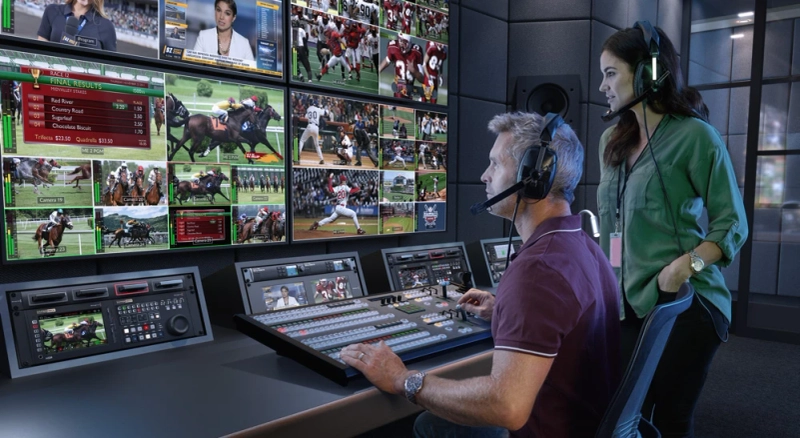Broadcast switchers are the backbone technology enabling televised productions. They allow directors and technical operators to transition seamlessly between different camera angles, graphics, audio sources and more during a live broadcast or recording. Let's take a deeper look at how they work and the different types available.
What is a Broadcast Switcher?
It is a specialized electronic device that routes multiple video and audio source signals to a single output destination. Sources can include cameras, replay systems, graphics, clips and more. The output of the switcher then feeds a monitor, recording device or transmission system. They contain rows of buttons and switches corresponding to each input source. Operators use these interfaces to transition rapidly between sources during a live production.
Switcher Controls
Typical switcher interfaces include buttons for transitions, source selection, layers and effects. Transition buttons determine how the Broadcast Switchers happens, such as cuts, dissolves and wipes. Source buttons route the selected input to the program output. Multi-view controls display multiple sources simultaneously for monitoring. Aux and preview buttons enable the technical director to set up the next shot in preview before committing to air. Embedded controls activate in-built graphics, titles and other branding elements.
Transition Effects
A wide range of transition effects are possible using advanced broadcast switchers. Basic options include straight cuts, dissolves and wipes. More complex effects include animation store transitions that can move elements around the screen during changes. Multi-layer transitions overlay sources for creative reveals. Another option are stinger transitions which temporarily lock on a logo, graphic or source before moving on to the new shot. They offer precise transition timing down to single frames for polished operation.
Switcher Types and Features
There are different types of them suitable for a range of production needs and budgets. The higher-end router-based switchers used by television networks and large broadcast facilities can support hundreds of simultaneous sources across multiple video and audio layers. Mid-sized production switchers for OB vans and local broadcast studios typically support 4-32 simultaneous inputs. Smaller compact switchers are ideal for portable live streaming and editing applications requiring 8 or fewer concurrent sources.
Beyond source counts and layer depth, key switcher features to consider include integrated multi-viewers, clip and still stores, production control software integration, advanced chroma keying and virtual sets. Advanced remote control panel options also allow the technical director to be stationed anywhere in the production area rather than tied to the switcher itself. 3D effects and eye-catching transitions have become expected capabilities on even modestly priced switchers today.
Integrated Multi-View and Monitor Wall Control
Many modern switchers incorporate integrated multi-viewers, eliminating the need for separate multi-viewer units. Models designed for larger facilities have dedicated monitor wall control capabilities. This enables the technical director to configure complex arrays of video walls across multiple physical displays directly from the switcher user interface without additional hardware. Being able to precisely position sources, transitions and effects across multiple screens is essential for productions with sophisticated monitor walls.
Clip and Still Stores for Graphic Transitions
Most switchers feature clip and still graphic stores allowing animated transitions between branding elements, replays, title pages and more. Stored transitions provide eye-catching moves between sources without the need for an external graphics system. Files are either loaded directly into the switcher or via a connected clip server. Still stores offer basic storage of titling pages and branding elements while clips stores support full motion replays and animations.
Integrations with Third-Party Software
Advanced switchers also integrate tightly with popular outside production control software like Ross Video's OverDrive, Grass Valley's Ignite and NewTek's Live Desktop. Full control over source selection, transitions, clip playback and other capabilities is replicated on the powerful production control interfaces. This allows a single technical director or assistant to command all production elements from a centralized workstation while monitoring on larger screens.
Virtual Set Functionality
Virtual sets became a standard feature on today's mid-range and high-end switchers. Built-in virtual set processors allow realtime compositing of camera sources against digitally created studio environments. Technical directors activate preset virtual set configurations at the touch of a button, vastly improving the production value of shows compared to shooting against plain studio walls. Set designs can be as elaborate as studios can afford to license.
4K/UHD and IP Workflow Support
As resolution standards rise, the latest generation of broadcast switchers fully support 4K/UHD formats for ambitious productions. This allows high quality sources like aerial camera drones to integrate seamlessly into the switcher workflow. New IP-enabled switchers can also leverage emerging IP infrastructures for dense source connectivity, remote production capabilities and seamless integration into SDI, HDMI or IP environments.
Broadcast switchers remain the indispensable core technology enabling millions of live television productions each year across broadcasters worldwide. Rapidly advancing capabilities now allow a single technical director wielding an advanced software-defined switcher to command productions far more sophisticated than were possible even a few years ago. As resolution standards increase and IP becomes the dominant infrastructure, software-centric switchers will unlock new frontiers in live content creation and remote operations.
Get More Insights On, Broadcast Switchers
About Author
Alice Mutum is a seasoned senior content editor at Coherent Market Insights, leveraging extensive expertise gained from her previous role as a content writer. With seven years in content development, Alice masterfully employs SEO best practices and cutting-edge digital marketing strategies to craft high-ranking, impactful content. As an editor, she meticulously ensures flawless grammar and punctuation, precise data accuracy, and perfect alignment with audience needs in every research report. Alice's dedication to excellence and her strategic approach to content make her an invaluable asset in the world of market insights.(LinkedIn: www.linkedin.com/in/alice-mutum-3b247b137)



